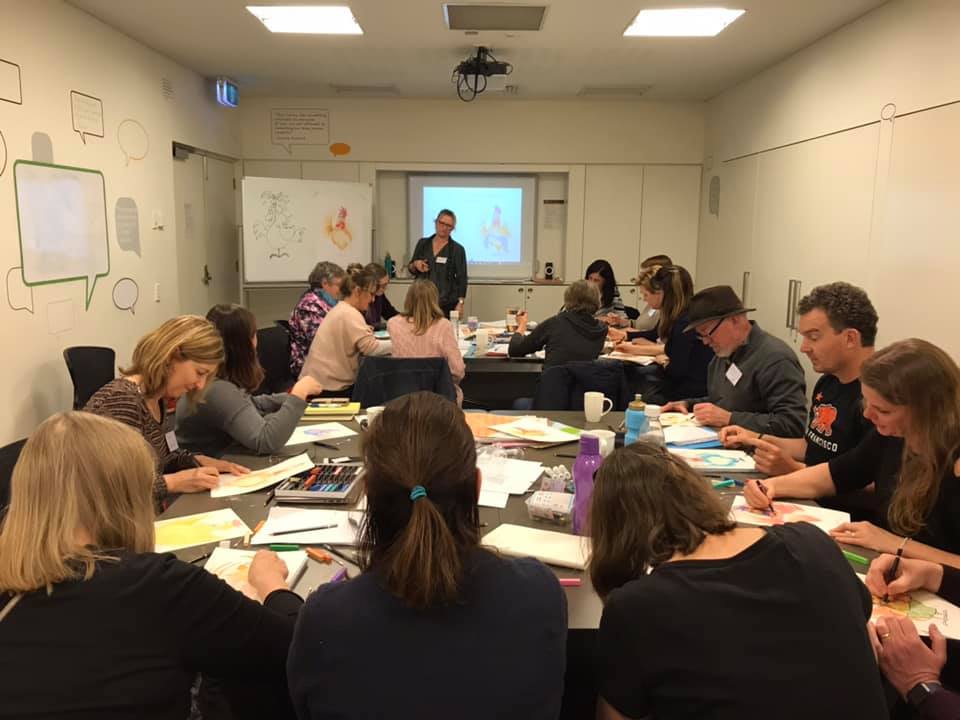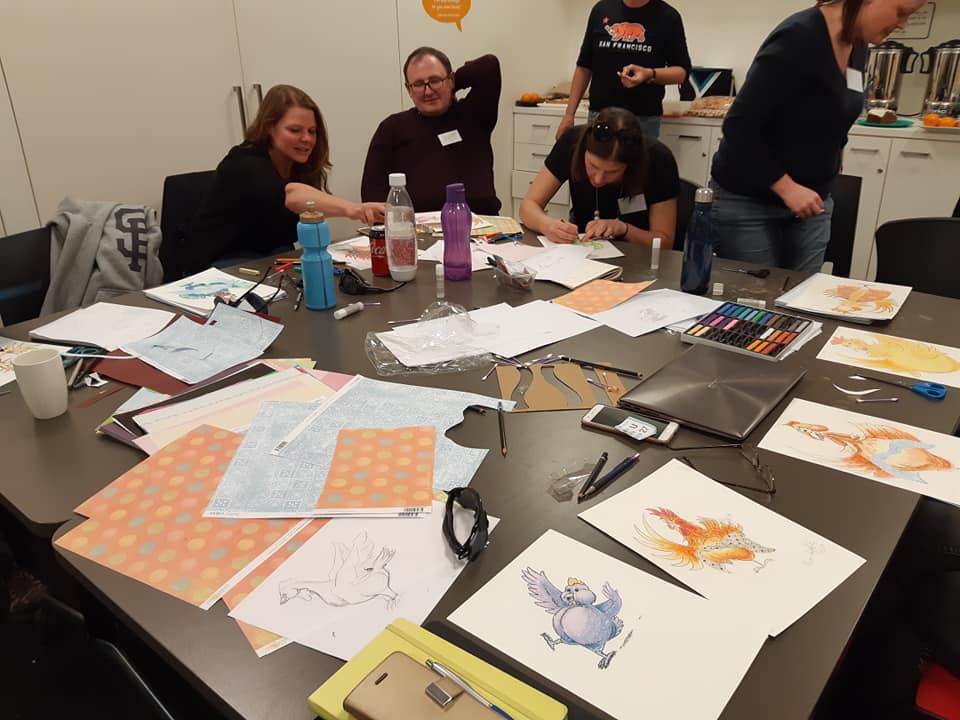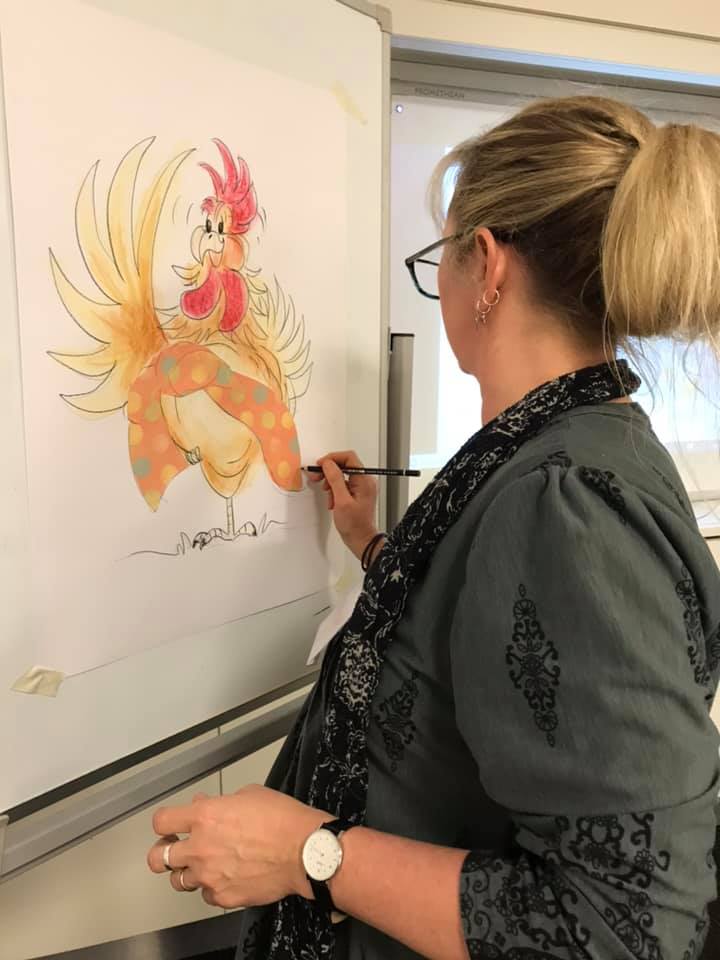by Alys Jackson
Some members arrived early to the Coventry Library, Stirling, for the Winter Retreat on July 20 2019. While many began busily setting up the lunch table, those booked into critique sessions had the wonderful opportunity to have their work read and feedback delivered in an open, professional atmosphere. Kelly Hibbert then kicked off what was to be a day packed with wisdom and chickens.
South Australian artist, Claire Richards, offered up some great tips on using drawing as a tool for writing. Drawing is, she believes, a great way to work through writers block or at least to enable us to catch those fleeting ideas in a way that keeps the originality of the initial thought.
Claire’s top tips:
· create a pinboard – for images and ideas
· get into costume – hats help when writing dialogue
· strike a pose – it can help bring out a character’s personality
· draw stick figures – so you don’t get attached to a particular style of illustration
· give drawn characters memsorable features to help recall them
· mind maps – are a useful way to develop characters or a plot
· map out your storyline to check details and find the Point of No Return
· get out – sketch and write in places where you can be quietly observant
· family trees – help to visualise how characters connect
· aerial maps – help to visualise places
Carrie Gallasch - The Story Behind the Stories
Author Carrie Gallasch offered us an insight into what it means to be a writer. She started by reminding us that everyone has a story. Don’t be put off by self-doubt, she advised. It is important to acknowledge the doubts you may have and to admit that you do care.
As a child, Carrie hated literacy and reading. It was outdoors where she finally discovered her creativity. Children, she believes, need to be bored; it is the platform for creativity and something sorely lacking in today’s fast-paced digital world. If boredom is the driving force of creativity, then pain, she says, is the purpose. She suggested we ask ourselves why we do what we do, perhaps even to write a mission statement.
For Carrie, nature is the inspiration behind her writing. She explained how she often uses her camera to capture moments that might later become the ‘seed’ of a story. She shared some of her photographs each filled with small but important details; a crate of oranges left out by a neighbour, a laughing child, and autumn leaves. Explore your senses, she advised, and tap into your memories, it is these things that make a story sing.
Carrie’s top tips:
· learn to love and accept your talents – we all get rejections
· take the time to stop and notice details – look for the seed of a story
· take a writers course
· enter competitions to get feedback
· manuscript assessments can be invaluable
· write down key words if you have a story idea
· every story must have a problem
· if something frustrates you in life use it to create a story
· go to writers festivals to get feedback and to make contacts
· publishers look for illustrators on Instagram
Mandy Foot – This is MY chicken
Author/illustrator, Mandy Foot delivered a fun-filled workshop in which she took us through the step-by-step process of drawing a chicken – one of the stars of the soon-to-be published The Hip Hop Barn by Phil Cummings, and illustrated by Mandy.
Mandy realised quite early on in life that a regular job was not for her. At nine she won a school competition to design a stamp and later completed a Bachelor’s Degree in design, specialising in illustration. Twenty plus books later, she is now an ambassador for Raising Literacy Australia.
Mandy began by showing us the work of various chicken-drawing artists, including Gabriel Evans, Danny Snell and Leigh Hobbs.
While we tackled the task of creating an identifiable chicken-like illustration with watercolour paper, pastels and wax pencils, Mandy took us through the writing and illustrating of her latest book, Joey and Riley, published by Hachette Australia, July 2019. When she first submitted the manuscript to her publisher, Mandy was told that she needed to strengthen the plot, to ‘take something away from the reader’. It took many more years of writing and editing for Mandy to complete what is a beautiful story. When asked, which is harder, writing or illustrating? Mandy replied writing to which many of us would politely disagree. Three of Mandy’s illustrations are part of the Phil Cummings Exhibition, Stories Behind the Books, at the State Library Adelaide – ending 29th Sept, 2019.
SCBWI Sydney Conference Wrap Up
Kelly Hibbert and members, Lauren Mullinder and David Lewis attended the Sydney SCBWI Conference, February, 2019. Here are some of their thoughts.
Why attend a conference?
· It is nice to be able to put faces to names and to network – Kelly/David
· Attendees gain first hand insights from writers, publishers and agents both local and international
· There is nothing like meeting people in person
Lauren suggested staying at the venue. It is a great way to chat to participants, including agents and publishers, informally.
It costs between $1000 to $2000 to attend a conference, including travel, accommodation and food.
What was your lightbulb moment?
· Finding out what is meant by ‘target your publisher’. Publishers look for tone and atmosphere rather than subject matter – Lauren
· Literary agent, Brian Cook advised that he turns to page 69 of a manuscript to assess a writers ‘voice’ – David
· Vivian Kirkfield listed the ingredients to success in publishing as: productivity, passion, patience and persistence – to which Kelly added point of difference/personality
Advice for members considering attending a SCBWI conference:
· do as much as you can and try to attend the dinner – Lauren
· take your time and make a few solid connections – Kelly
Final thought from David. In the words of US blogger, Vivian Kirkfield: ‘a story that sings doesn’t get seen if it stays in your drawer.’
And on that final note, we ended another great SCBWI day.















